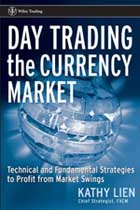.jpg)
Follow
Us:    
|
Broaden Your Options
Investing Horizon
Date: Wednesday January 17th
Time: 3:30pm CT
Join Avant-Garde Trading with special guest Wendy Kirkland for an educational webinar. The self-made trader and financial author will discuss how she trades the market.
Click Here to Register
As an added bonus ALL attendees will receive a free giveaway courtesy of Wendy!
Space is limited so Register Here Now for this educational webinar!

|
|
Kathy Lien is the Chief Currency Strategist at Forex Capital Markets LLC (FXCM). She is responsible for providing research and analysis for DailyFX, including technical and fundamental research reports, market commentaries and trading strategies. Prior to joining FXCM, Kathy was an associate at JPMorgan Chase, where she worked in cross-markets and foreign exchange trading.
She has vast experience within the interbank market using both technical and fundamental analysis to trade FX spot and options. She also has experience trading a number of products outside of FX, including interest rate derivatives, bonds, equities and futures.
Kathy has written for MarketWatch from Dow Jones, Active Trader, Futures and SFO magazines. She has taught currency trading seminars across the country, has appeared on CNBC and is frequently quoted on Bloomberg and Reuters.
 |
Day Trading the
Currency Market

Technical and Fundamental Strategies to Profit
from Market Swings
This book is broken down into chapters ranging from a beginner's guide to terminology and the history of FX markets through to trading strategies, all of which briskly moves forward into more advanced and comprehensively fleshed out sub-sections. Filled with in-depth yet accessible information, thanks wholly to the author's no-nonsense writing style, Day Trading the Currency Market can show you how to enter this highly competitive arena with confidence and exit with profits.
Included with this book are two bonus items:
- The Beginner's Guide to Success in Today's FX Currency Markets
- Secret Forex Trading Techniques
Learn More About
Day Trading the Currency Market
|
|

Better
Business Bureau
 |
|
Click on authors name
to learn more
|
| |
|
|
As for today, our next round of opportunities can be found in crypto-related stocks. Crypto currencies aren’t the only investments turning thousands into millions of dollars. In fact, any stock even remotely related to the crypto boom has been just as exciting.
Then, Lee Gettess provides his perspective on both the S&P and the bond market for the coming week.
Next, Kathy Lien explains how to use option volatilities to spot foreign exchange movements in the marketplace.
Last, Andy Chambers shares his Weekly Market Line in the Sand Newsletter.
Enjoy!
Adrienne LaVigne
TradeWins Publishing
 |
|
Four of the Most Explosive Crypto Stocks to Own
by
TradeWins Publishing
Let’s start with some profit taking.
Over the last few weeks, we recommended taking a position in explosive marijuana stocks. And so far, they have yet to disappoint.
- Kush Bottles (KSHB) ran from $3.80 to $5.45 – Sell half
- Lifestyle Delivery (LDSYF), which ran from 72 cents to 82 cents
- OrganiGram Holdings (OGRMF), which ran from $3.50 to $3.95
- Aphria Inc. (APHQF), which ran from $14.05 to $16.95—Sell half
- Canopy Growth (TWMJF), which ran from $24 to $31.70 – Sell half
Congratulations on the wins. On pullbacks, we may look to buy even more.
As for today, our next round of opportunity can be found in crypto-related stocks.
Crypto currencies aren’t the only investments turning thousands into millions of dollars.
In fact, any stock even remotely related to the crypto boom has been just as exciting.
Eastman Kodak (KODK) just announced it was launching Kodak Coin, a crypto currency for photographers. As a result, shares exploded from $3.10 to $13 in just days, in January 2018. According to The Verge:
KodakCoins will work as tokens inside the new blockchain-powered KodakOne rights management platform. The platform will supposedly create a digital ledger of rights ownership that photographers can use to register and license new and old work. Both the platform and cryptocurrency are supposed to “empower photographers and agencies to take greater control in image rights management.”
Explosive Crypto Stocks
|
Lee
Gettess' Market Sense
by Lee Gettess
Lee
Gettess is a top trader who is excited
to bring you his video newsletter.
Each week, Lee will share his predictions
on what he anticipates from the bond
and S&P markets.
Watch
Video
|
Using Option Volatilities to Time Market Movements
by
Kathy Lien
The following
is an excerpt from Kathy Lien's Day Trading the Currency Market
Using option volatilities to time foreign exchange spot movements is a very useful strategy that is a favorite among professional hedge funds. Implied volatility can be defined as a measure of a currency’s expected fluctuation over a given time period based on past price fluctuations. This is typically calculated by taking the historic annual standard deviation of daily price changes. Future prices help to determine implied volatility, which is used to calculate option premiums. Although this sounds fairly complicated, its application is not. Basically, option volatilities measure the rate and magnitude of a currency’s price over a given period of time based on historical fluctuations. Therefore, if the average daily trading range of the EUR/USD contracted from 100 pips to 10 pips and stayed there for two weeks, in all likelihood short-term volatility also contracted significantly compared to longer-term volatility during the same time period.
As a guideline, there are two simple rules to follow. The first one is that if short-term option volatilities are significantly lower than long-term volatilities, one should expect a breakout, though the direction of the breakout is not defined by this rule. Second, if short-term option volatilities are significantly higher than long-term volatilities, one should expect a reversion to the trading range.
Why Do These Rules Work?
During a ranging period, implied option volatilities are either low or on the decline. The inspiration for these rules is that in periods of range trading, there tends to be little movement.
Using Option Volatilities
|
Weekly Market Line in the Sand
by Andy Chambers
Every week Andy publishes his Weekly Market Line in the Sand newsletter. The following are trade updates from his most recent issue.
The trend is up, the bulls have the momentum, and there are no signs of a top. There are no new orders.
One of the XLU puts expires on Friday. It’s not in the money right now, but it could be by Friday. If it is, be sure to exit before the market closes on Friday. If it expires in the money, it will be exercised.
S&P E-Mini Futures Weekly: The trend is up. The next target is 2825. A weekly close below 2667.75 could mark at least a short term top.
DIA Weekly: The trend is up. The next targets are 275 and 300. A weekly close below 246.88 could mark at least a short term top.
On 8/13 we said: We want to buy the DIA January 19, 2018 220 Put at the market. 8/14-Bought to Open at 7.55. We made $920 on the call we exited. Between the put and call, we will make at least $165.
To Learn More Click Here
|
|